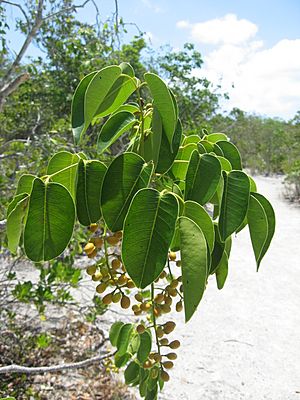Poisonwood facts for kids
Quick facts for kids Poisonwood |
|
|---|---|
 |
|
| Scientific classification | |
| Genus: |
Metopium
|
| Species: |
toxiferum
|
The poisonwood tree, also known as Florida poisontree or hog gum, is a type of flowering tree. It belongs to the cashew and sumac family, called Anacardiaceae. This tree is native to the American Neotropics, which includes parts of Florida and the Caribbean.
Poisonwood is famous because it produces an oily substance called urushiol. This is the same irritant found in its relatives, poison sumac and poison oak. If you touch the sap or even the smoke from burning poisonwood, it can cause an itchy rash.
Contents
What is the Poisonwood Tree?
The poisonwood tree (Metopium toxiferum) is a common sight in southern Florida and the Florida Keys. You can also find it growing in The Bahamas and other islands throughout the Caribbean. It is a close relative of the black poisonwood tree (Metopium brownei).
Where Does Poisonwood Grow?
Poisonwood trees like warm, sunny places. They often grow in coastal areas and Everglades habitats in Florida. They are well-adapted to sandy soils and can be found in various ecosystems, from hammocks to pinelands.
Why is it Called Poisonwood?
The name "poisonwood" comes from the tree's ability to cause a skin reaction. The sap, leaves, and bark of the tree contain urushiol. This is a clear, oily liquid that can cause an allergic reaction in many people.
What Happens if You Touch It?
If urushiol touches your skin, it can cause an itchy, red rash. This rash might also have blisters. The reaction can be mild or severe, depending on how sensitive a person is and how much urushiol they touched. It's best to avoid touching any part of the poisonwood tree.
How to Identify Poisonwood
Poisonwood trees can grow up to 35 feet (11 meters) tall. They have shiny, dark green leaves that grow in clusters of three to seven leaflets. The bark is usually reddish-brown and can look flaky. One of the easiest ways to spot it is by its black sap. If the bark is scratched, a black, sticky sap will ooze out. This sap turns black when exposed to air.
Poisonwood Berries and Flowers
The tree produces small, yellowish-green flowers. These flowers grow in clusters and are not very noticeable. After the flowers, small, orange-red berries appear. These berries are round and about half an inch (1.2 cm) wide. Birds and other wildlife eat these berries, but they are not safe for humans to eat.
Safety Tips Around Poisonwood
It is important to be careful around poisonwood trees, especially if you are hiking or exploring in areas where they grow.
- Do not touch the tree: Avoid touching the leaves, bark, or sap.
- Do not burn it: Burning poisonwood can release urushiol into the air. Breathing in the smoke can cause a severe reaction in your lungs.
- Wash thoroughly: If you think you have touched poisonwood, wash the affected skin with soap and water as soon as possible.
- Wear protective clothing: If you are in an area with poisonwood, wear long sleeves and pants to protect your skin.
Remember, even dead poisonwood trees can still contain urushiol and cause a reaction. Always be aware of your surroundings when exploring nature!
See also
 In Spanish: Metopium para niños
In Spanish: Metopium para niños

